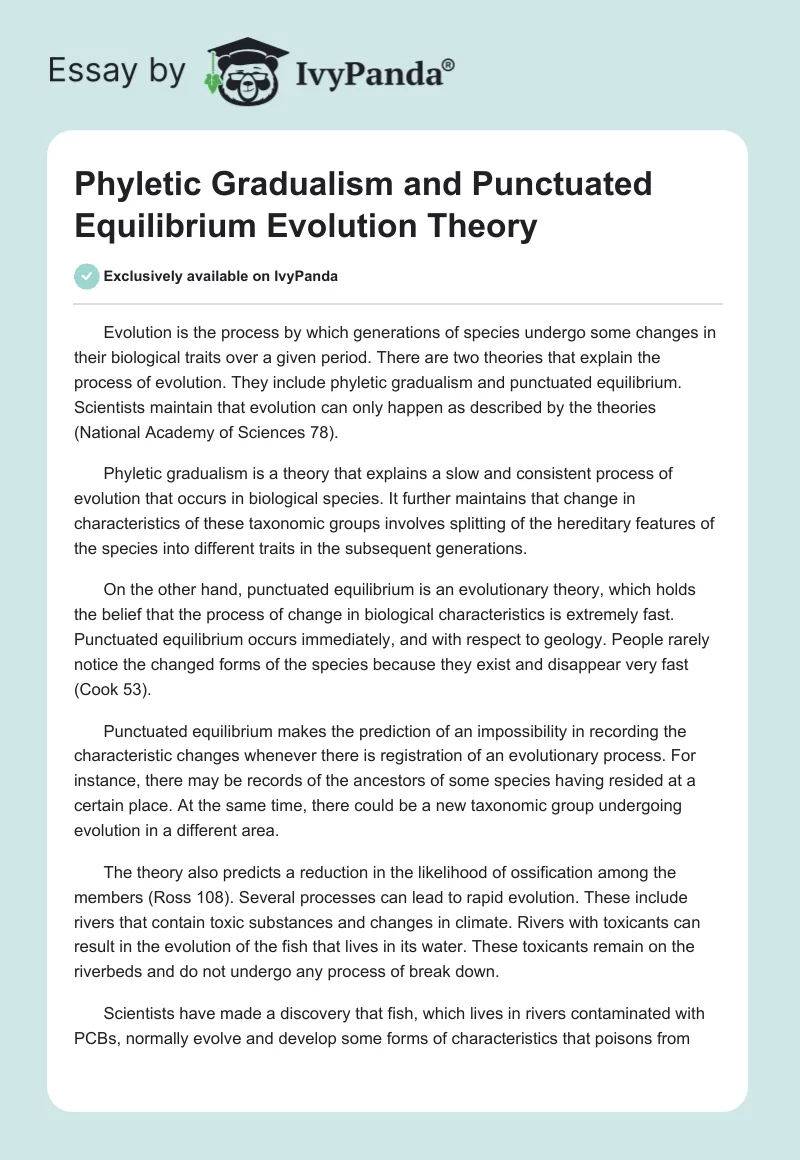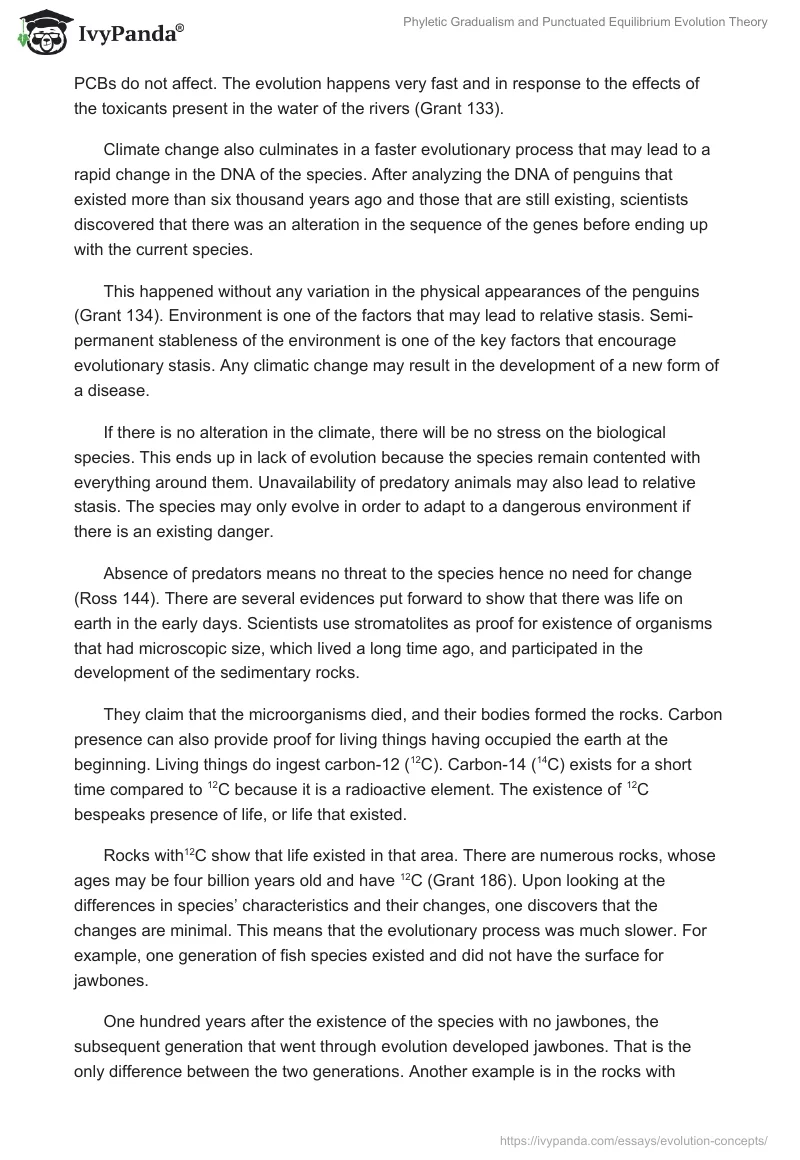Evolution is the process by which generations of species undergo some changes in their biological traits over a given period. There are two theories that explain the process of evolution. They include phyletic gradualism and punctuated equilibrium. Scientists maintain that evolution can only happen as described by the theories (National Academy of Sciences 78).
Phyletic gradualism is a theory that explains a slow and consistent process of evolution that occurs in biological species. It further maintains that change in characteristics of these taxonomic groups involves splitting of the hereditary features of the species into different traits in the subsequent generations.
On the other hand, punctuated equilibrium is an evolutionary theory, which holds the belief that the process of change in biological characteristics is extremely fast. Punctuated equilibrium occurs immediately, and with respect to geology. People rarely notice the changed forms of the species because they exist and disappear very fast (Cook 53).
Punctuated equilibrium makes the prediction of an impossibility in recording the characteristic changes whenever there is registration of an evolutionary process. For instance, there may be records of the ancestors of some species having resided at a certain place. At the same time, there could be a new taxonomic group undergoing evolution in a different area.
The theory also predicts a reduction in the likelihood of ossification among the members (Ross 108). Several processes can lead to rapid evolution. These include rivers that contain toxic substances and changes in climate. Rivers with toxicants can result in the evolution of the fish that lives in its water. These toxicants remain on the riverbeds and do not undergo any process of break down.
Scientists have made a discovery that fish, which lives in rivers contaminated with PCBs, normally evolve and develop some forms of characteristics that poisons from PCBs do not affect. The evolution happens very fast and in response to the effects of the toxicants present in the water of the rivers (Grant 133).
Climate change also culminates in a faster evolutionary process that may lead to a rapid change in the DNA of the species. After analyzing the DNA of penguins that existed more than six thousand years ago and those that are still existing, scientists discovered that there was an alteration in the sequence of the genes before ending up with the current species.
This happened without any variation in the physical appearances of the penguins (Grant 134). Environment is one of the factors that may lead to relative stasis. Semi-permanent stableness of the environment is one of the key factors that encourage evolutionary stasis. Any climatic change may result in the development of a new form of a disease.
If there is no alteration in the climate, there will be no stress on the biological species. This ends up in lack of evolution because the species remain contented with everything around them. Unavailability of predatory animals may also lead to relative stasis. The species may only evolve in order to adapt to a dangerous environment if there is an existing danger.
Absence of predators means no threat to the species hence no need for change (Ross 144). There are several evidences put forward to show that there was life on earth in the early days. Scientists use stromatolites as proof for existence of organisms that had microscopic size, which lived a long time ago, and participated in the development of the sedimentary rocks.
They claim that the microorganisms died, and their bodies formed the rocks. Carbon presence can also provide proof for living things having occupied the earth at the beginning. Living things do ingest carbon-12 (12C). Carbon-14 (14C) exists for a short time compared to 12C because it is a radioactive element. The existence of 12C bespeaks presence of life, or life that existed.
Rocks with12C show that life existed in that area. There are numerous rocks, whose ages may be four billion years old and have 12C (Grant 186). Upon looking at the differences in species’ characteristics and their changes, one discovers that the changes are minimal. This means that the evolutionary process was much slower. For example, one generation of fish species existed and did not have the surface for jawbones.
One hundred years after the existence of the species with no jawbones, the subsequent generation that went through evolution developed jawbones. That is the only difference between the two generations. Another example is in the rocks with traces of microorganisms. There are remains of microorganisms with single cells in a rock that is five hundred and fifty million years old.
A second rock that is five hundred years old has microorganisms with multiple cells. Changes in cells are the only evolutionary processes seen in the microorganisms (Hey 173). Fossil records act as support for punctuated equilibrium. There are cases of tracing a species only within certain duration of time, and then it disappears completely.
The species took long before undergoing any form of characteristic change and then evolved very fast, leaving no evidences for its initial form (Ross 57). In conclusion, evolution is a process that can occur acutely fast or slow. It can lead to the complete disappearance or change in some characteristics of the species. Pollution of the environment and changes in climate may lead to evolution.
People should ensure that toxicants do not find their way into the environment. They should also ensure that they do not engage in activities that may result in climatic alterations, which may culminate in evolution. There are evidences of life in the early years, but the species disappeared due to ecological changes.
Works Cited
Cook, Fuller Orator. Methods and Causes of Evolution. Washington: U.S. Government Printing Office, 1908. Print.
Grant, Peter R., & Grant, Rosemary B. In Search of the Causes of Evolution: From Field Observations to Mechanisms. Princeton: Princeton University Press, 2010. Print.
Hey, Jody. Genes, Categories, and Species : The Evolutionary and Cognitive Cause of evolution. Oxford: Oxford University Press, 2001. Print.
National Academy of Sciences. In the Light of Evolution III: Two Centuries of Darwin. Washington: National Academies Press, 2009. Print.
Ross, Robert M. , & Allmon Warren D. Causes of Evolution: A Paleontological Perspective. Chicago: University of Chicago Press, 1990. Print.


